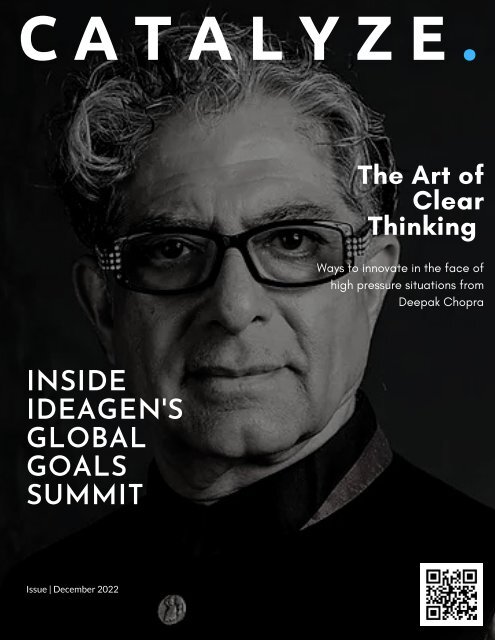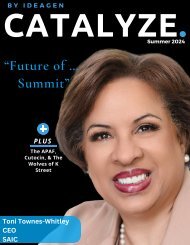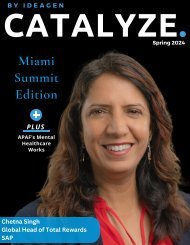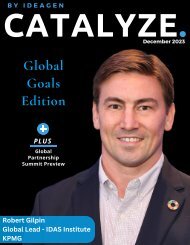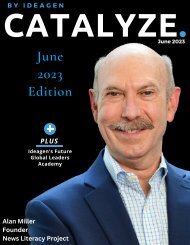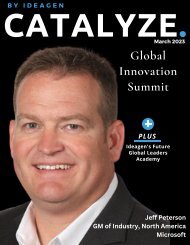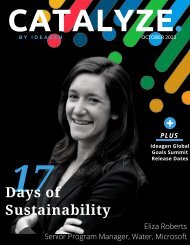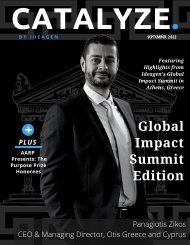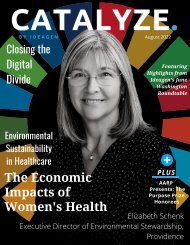Catalyze December
Create successful ePaper yourself
Turn your PDF publications into a flip-book with our unique Google optimized e-Paper software.
C A T A L Y Z E .<br />
The Art of<br />
Clear<br />
Thinking<br />
Ways to innovate in the face of<br />
high pressure situations from<br />
Deepak Chopra<br />
INSIDE<br />
IDEAGEN'S<br />
GLOBAL<br />
GOALS<br />
SUMMIT<br />
Issue | <strong>December</strong> 2022
C A T A L Y Z E .<br />
The Art of<br />
Clear<br />
Thinking<br />
Ways to innovate in the face of<br />
high pressure situations from<br />
Deepak Chopra<br />
INSIDE<br />
IDEAGEN'S<br />
GLOBAL<br />
GOALS<br />
SUMMIT<br />
Issue | <strong>December</strong> 2022
C A T A L Y Z E .<br />
The Art of<br />
Clear<br />
Thinking<br />
Ways to innovate in the face of<br />
high pressure situations from<br />
Deepak Chopra<br />
INSIDE<br />
IDEAGEN'S<br />
GLOBAL<br />
GOALS<br />
SUMMIT<br />
Issue | <strong>December</strong> 2022
C A T A L Y Z E .<br />
The Art of<br />
Clear<br />
Thinking<br />
Ways to innovate in the face of<br />
high pressure situations from<br />
Deepak Chopra<br />
INSIDE<br />
IDEAGEN'S<br />
GLOBAL<br />
GOALS<br />
SUMMIT<br />
Issue | <strong>December</strong> 2022
Index<br />
Table of<br />
Contents<br />
Section 1<br />
Deepak Chopra and<br />
Robert Reiss discuss<br />
the status of the<br />
world today and how<br />
each of us can be a<br />
solution to modernday<br />
problems<br />
Section 2<br />
Featured Speakers Include...<br />
Making Mental Health<br />
Mainstream, Featured<br />
interview with Rawle<br />
Andrews Jr:<br />
Section 3<br />
Gretchen O’Hara and the<br />
Great Data Divide<br />
Section 4<br />
Sanjay Rishi and the<br />
Workplace of the Future<br />
Section 5<br />
Grace Clack and an<br />
optimistic outlook on<br />
current climate progress
About The Global<br />
Goals Summit<br />
Live From the UN ECOSOC<br />
Chamber<br />
Ideagen has the unique capacity and privilege to<br />
bring together leaders from a variety of<br />
companies, organizations, and NGOs, The Global<br />
Goals Summit is a forum for executive-level<br />
leaders to discuss the impacts of The Global Goals<br />
on their business and provide solutions to one or<br />
more of the Global Goals.<br />
The Summit's agenda covers topics such as<br />
philanthropy and the public sector, financing for<br />
the SDGs, gender equality, the connection<br />
between health and technology, and more.<br />
Read articles and excerpts from some of the<br />
world's most impactful global leaders speaking at<br />
Ideagen's most anticipated summit to date.<br />
Page 02
Deepak Chopra<br />
Section 1<br />
Section 1<br />
Section 1<br />
The Art of Clear<br />
Thinking<br />
Deepak Chopra's<br />
S-T-O-P Method of<br />
Thinking<br />
Robert Reiss:<br />
What are the first steps for someone who<br />
maybe has a hard time relaxing,<br />
meditating and thinking clearly? And<br />
maybe everyone reading this right now at<br />
home or, anywhere, really, can try your<br />
suggestion.<br />
Deepak Chopra:<br />
They can use what I call the STOP formula,<br />
S-T-O-P. So, before reacting to any<br />
situation or any stressful circumstance<br />
you simply stop.<br />
S stands for smiling from your head to<br />
your toes. This stimulates the vagus<br />
nerve, which is the healing nerve in your<br />
body. Lots of evidence shows that smiling<br />
changes your biology, especially if you<br />
imagine smiling from your head to your<br />
toes<br />
Literally let everything smile. Your nose,<br />
your lips, your tongue, your ears, your<br />
neck, your heart, your fingernails, even<br />
your genitalia. Everything is smiling.<br />
Next is T- take 3 three deep breaths and<br />
keep that smile. Let your body slide into a<br />
deeper state of relaxation with each<br />
exhale. O- Observe your body and it’s<br />
sensations. Observe the environment<br />
without judgment. Then P- proceed with a<br />
decision with awareness and compassion.<br />
S-T-O-P.
Section 2<br />
THE GREAT<br />
DATA DIVIDE<br />
B y G r e t c h e n O ' H a r a<br />
<br />
Technology continues to grow and we<br />
all know it moves in leaps and bounds.<br />
Technology is emerging as this new<br />
currency that's driving insight, decisionmaking,<br />
and ultimately knowledge. So<br />
today, as a result, data is now being<br />
produced, consumed, and stored at<br />
dizzying rates. The world has witnessed<br />
the explosion of tenfold growth in data<br />
by Zettabytes since 2013, and we will<br />
see that doubling by 2025. What does<br />
that mean to all of us? Organizations<br />
now are mining. They're collecting,<br />
storing, and securing more data to take<br />
advantage of what essentially now is<br />
this new digital currency, this new gold.<br />
However, while these mountains of data<br />
are being leveraged at breakneck speed<br />
and keeping pace with the growth,<br />
they're really not being leveraged yet<br />
for the benefit of everybody. That is<br />
where you the reader comes in.<br />
There is a growing disparity and the<br />
expanding use of data to create<br />
commercial value and the<br />
comparatively weak use of data to solve<br />
social and environmental challenges.<br />
This data divide is something that I<br />
believe is absolutely separating us and<br />
we have an opportunity and an<br />
obligation together to really change<br />
that. The haves include people and<br />
companies, organizations with plenty of<br />
fresh data that they have that they can<br />
use with the skills that they've been able<br />
to acquire to grow and thrive. While the<br />
have-nots are those that are operating<br />
with a limited sense of data and have no<br />
ability or the skills to be effective with<br />
that data. And what ultimately happens<br />
is that stunts the economic growth and<br />
social advancement as a result of this<br />
data divide.
"This data divide is something that I believe<br />
is absolutely separating us, and we have an<br />
opportunity and an obligation together to<br />
really change that."<br />
This is a crisis that we have to all<br />
come together on. Now, collective<br />
progress continues to be lagging and<br />
it's broadening the chasm as we<br />
speak because of the rate of change<br />
in the massive data that we're<br />
growing.<br />
While these data strategies have<br />
certainly benefited commercial<br />
companies, public sector nonprofits<br />
lag in the education, the skills of the<br />
future workforce, the tools, and the<br />
talent to even access that<br />
information. That means individuals<br />
in underserved communities in most<br />
cases aren't even at the starting line<br />
of what will be the new world of a<br />
data-driven world.<br />
So, what do we have to do about<br />
that? Let me just put a stark reality<br />
of an example in front of us. We can<br />
just look at Covid 19 as a great<br />
example of the crisis of the data<br />
divide. If you can remember back to<br />
the very beginning of the first few<br />
weeks and months of the Covid<br />
Pandemic, there was covid testing<br />
work that was being done across the<br />
globe. But in particular, one<br />
example was a Biohub group<br />
initiative with the University of San<br />
Francisco, California.<br />
This bio hub built covid testing lab<br />
and capabilities in seven days.<br />
Meaning, they were able to not only<br />
get this lab up and running in seven<br />
days they were able to produce lab<br />
results within 24 hours. Think about<br />
this, not knowing anything within<br />
really the first weeks of the<br />
pandemic, but what happened with<br />
data was that they made this<br />
available for all of California to use,<br />
free for the public health system.<br />
The public health system became<br />
so overwhelmed they were even<br />
using fax machines to keep up<br />
with the amount of information<br />
that was coming back from the<br />
data provided. Can you imagine<br />
all of this data available in seven<br />
days promising 24-hour results?<br />
If we had more access to data like<br />
this in the hands of everyone, we<br />
could have kept up and paced<br />
with the speed at which the<br />
pandemic was taking hold
To learn more
MAKING MENTAL HEALTH<br />
MAINSTREAM<br />
As the largest psychiatric organization in the world,<br />
how do you utilize partnerships to achieve absolutely<br />
vital and critical global missions?<br />
Section 3<br />
I always say there are three<br />
C’s that actually go into how<br />
we work with partnerships. One<br />
is competency, the other is<br />
collaboration and the last is<br />
capacity. So, one of the things<br />
that we have learned over 30<br />
plus years of working as part of<br />
the APA (American<br />
Psychological Association) is<br />
that the APA Foundation does<br />
well as a convener, and it does<br />
very well as a thought leader.<br />
VOLUME II<br />
The APA also does great work<br />
in philanthropy, but we cannot<br />
do it alone because there's just<br />
too much work to be done. And<br />
so what we try to do is find<br />
multidisciplinary partners so<br />
that we can cover as many of<br />
the facets of communities as<br />
we can. We work with faith<br />
leaders, we work with teachers,<br />
and educators. We work with<br />
B2B business managers and<br />
owners because they want to<br />
get more for their mission and<br />
out of their team. Sadly,<br />
sometimes they don't have a<br />
mental health partner. And the<br />
fact that we bring medical<br />
professionals to the table is<br />
huge<br />
I.E in one of the many<br />
communities we assist you're<br />
not just going to WebMD trying<br />
to figure this out for yourself.<br />
We give you a true md right?<br />
Right. We can help you work<br />
out whatever problem it is. And<br />
this is just a broad<br />
generalization of what we do in<br />
our partnerships. To give you a<br />
better idea of this; one of the<br />
things that we do is we host (in<br />
the APA foundation) a group<br />
called<br />
the Center for Workplace<br />
Mental Health. The Center for<br />
Workplace Mental Health is all<br />
about the idea of getting more<br />
out of business by treating<br />
managers' mental health. This<br />
gives managers better focus so<br />
that you don't have, in turn,<br />
staff feeling neglected, or<br />
overwhelmed and overworked<br />
because the manager is taken<br />
care of. And if the managers<br />
are happy, you have a happier<br />
employment contingent. Then<br />
they're going to want to do<br />
more for customers, clients,<br />
and so forth.<br />
Figure 1<br />
Rawle Andrews Jr: was<br />
featured at the Global Goals<br />
Summit on Behalf of the<br />
American Psychiatric<br />
Associatioon
PROGRESS<br />
IN CLIMATE<br />
PLEDGES<br />
Section 4<br />
There are 3,470 companies across the globe<br />
that have made climate pledges. Those<br />
companies add up to 80% of the world's GDP.<br />
So you can imagine the impact that those<br />
companies collectively have on global<br />
emissions and what the impact could be if they<br />
all reach net zero. The pressure is coming from<br />
all sides for these companies. Many of our<br />
investment funds today are putting financial<br />
pressure on companies that haven't made<br />
these pledges. 73% of investors say that efforts<br />
to improve the environment and society<br />
actually do impact their financial decisions.<br />
Next, I want to talk about the impact quotient,<br />
That's a great example. of how customers<br />
today are voting with their values. 77% of<br />
customers say that they're motivated to<br />
purchase from companies that are trying to do<br />
good in this world.<br />
It is worth mentioning regulators are also<br />
starting to tighten controls and reporting.<br />
Basically meaning that mandated reporting on<br />
sustainability issues is becoming more<br />
coommon<br />
And then last employees, employees want to<br />
work for companies that are doing good. 93%<br />
of employees say companies should lead with<br />
purpose. At Microsoft, we have 8,000<br />
employees in our sustainability community<br />
alone.
SUSTAINABLE<br />
Future<br />
WORKPLACES<br />
Section 5<br />
By: Dr. Sanjay Rishi<br />
I'm fortunate to be here to share<br />
some ideas on a topic that I'm very<br />
passionate about, and that passion<br />
will come out, so you might have to<br />
excuse me. The workplace has really<br />
changed. If you think about what the<br />
pandemic did with all the devastation<br />
that it caused, we're a resilient<br />
species and we have emerged from<br />
the pandemic. It’s with that, that the<br />
shadows of the pandemic and the<br />
opportunities that are emerging from<br />
the pandemic, and the lessons<br />
learned will really impact how we<br />
think about work, workplace<br />
workspaces, and workers.<br />
There are fundamental significant<br />
tectonic shifts that are happening in<br />
each one of those, some of the things<br />
that I'll touch on and more details<br />
around is as the shift, the idea of<br />
hybrid the idea of technology, and<br />
sustainability responsibility. One of<br />
the things we did with Joint Indication<br />
Indicators (Jll) about two years ago,<br />
as we said in our purpose statement,<br />
we put in a better world and we said<br />
we want our domain and our<br />
responsibility to create a better world.<br />
Well, that better world has many<br />
implications. It's around many of the<br />
things we address in this magazine<br />
like mental health, physical health,<br />
sustainability, diversity, equity, and<br />
inclusion.<br />
The way I group them around<br />
works that is; personalized<br />
work, which is responsible, and<br />
workspaces that are<br />
responsible Well, let's go<br />
exactly into those. When you<br />
talk about something like<br />
sustainability, there's an<br />
enormous impact on everything<br />
you're doing in the workplace.<br />
From a sustainability<br />
standpoint,<br />
I'll start with the example of the<br />
leaps and bounds we've come<br />
at Davos in 2020, in February<br />
just before the pandemic hit.<br />
There, you could see CEOs<br />
across the globe all making<br />
commitments around net zero<br />
carbon neutrality. One of the<br />
things that we're seeing is<br />
while those commitments were<br />
made, the question that I<br />
always ask when I'm with C<br />
suites and colleagues is- let's<br />
test and make sure that the<br />
road maps are implemented,<br />
that there are details around it<br />
that are getting the attention<br />
because there's so much going<br />
One of the things that we're seeing<br />
is while those commitments were<br />
made, the question that I always<br />
ask when I'm with C suites and<br />
colleagues is- let's test and make<br />
sure that the road maps are<br />
implemented, that there are details<br />
around it that are getting the<br />
attention because there's so much<br />
going on. There are<br />
macroeconomic headwinds, that<br />
are clearly impacting us.<br />
A little statistics for the audience,<br />
40% of the planet's carbon<br />
emissions come from built<br />
environments. We live in them, we<br />
work in them, we shop in them, we<br />
travel to airports, 40% comes from<br />
that, that's our business, that's my<br />
business to influence that. So, if<br />
we can influence it in partnership<br />
with everyone, this is no longer a<br />
debate. This is something that has<br />
to be done. And more importantly,<br />
the commitment to sustainability is<br />
real. It's happening across the<br />
globe. So, we're on a good path<br />
but we need partnerships like<br />
these to bring down that 40%<br />
statistic.<br />
on. 6
1<br />
D E E P A K C H O P R A<br />
G R E T C H E N O ' H A R A<br />
2<br />
3<br />
B A R B Q U A I N T A N C E<br />
R A W L E A N D R E W S<br />
4<br />
5<br />
G R A C E C L A C K
Section 6<br />
BLUE NILE'S<br />
DIAMOND<br />
NETWORK<br />
WITH BLUE NILE CEO SEAN KELL<br />
Ed Reno<br />
One of the questions that I think is<br />
potentially sensitive, but I just want to<br />
explore is in regards to diamonds in how<br />
you source them. I know there's a strong<br />
push for ethics in that process, and<br />
maybe you could frame for our audience<br />
what historically have been some of the<br />
concerns and considerations of the<br />
industry, and perhaps how Blue Nile has<br />
tried to responsibly come into the<br />
marketplace.<br />
Sean Kell<br />
Great question. So, for over 20 years<br />
now, blue Nile has been very focused on<br />
only sourcing diamonds in a sustainable<br />
conflict-free way. All of our diamonds are<br />
certified to be conflict free, which is a<br />
very specific set of processes and<br />
certifications to get there.<br />
Also increasingly there are sustainability<br />
requirements with different origin<br />
countries. Most diamonds come from<br />
Africa, Australia, and Canada, and that's<br />
where we source our diamonds from.<br />
The diamond's origin governments have<br />
put tremendous amounts of work into<br />
making sure that everything is ethically<br />
sourced and sustainably sourced.<br />
Because in many places, this is the<br />
primary GDP-driving product for the<br />
region.<br />
Sean Kell<br />
Oftentimes, diamonds provide a<br />
tremendous amount of resources for the<br />
population of these source and origin<br />
countries. So there's been a big push<br />
over the last 20, 30, and 40 years to<br />
make sure that all gem-quality diamonds<br />
are sourced sustainably and ethically in a<br />
conflict-free way.<br />
Ed Reno<br />
Right, so that's interesting to me in that<br />
Blue Nile does not have anyone with a<br />
pickax or a light on their head deep in a<br />
cave. Your partner is the regional<br />
authorities' government. Is that right?
Sean Kell<br />
We are a couple of steps from them, but yes. The diamond supply chain is a long and complicated one,<br />
and frankly, it's been this way for over a hundred years. So there's a mine in an origin country, generally<br />
owned by the government of that country. And they're contracting with a mining company like De<br />
Beers, who will help them source the diamonds in a sustainable and conflict-free ethical way. Then<br />
those diamonds are shipped to a central location, those are rough diamonds. It looks kind of like a piece<br />
of, scrap glass. Those pieces of rough diamond are then shipped to a central processing facility where<br />
people, and it's almost all done by hand, people will cut. That's right. Cut and polish those rough dull<br />
looking cloudy looking pieces of carbon into what we know as sparkly, gorgeous diamonds with<br />
different cuts and facets depending on the size and shape of the diamond. That is done typically in<br />
Belgium, Israel, and India. Then the diamonds kind of move their way through the supply chain, through<br />
distributors to secondary distributors, to third-tier distributors, and then ultimately to people like us,<br />
retailers.<br />
IDEAGEN TV PRESENTS<br />
AUTHENTIC LEADERSHIP<br />
WITH ED RENO<br />
Ed Reno<br />
Sean Kell<br />
CEO<br />
Blue Nile<br />
Diamonds<br />
Exclusively on IdeagenGlobal.com
Editor's Note<br />
Dear Ideagen Global Friends and Colleagues,<br />
As we prepare for the September 8th release of the Ideagen Global<br />
Impact Summit and 17 Days of Sustainability in October, Ideagen<br />
Global continues to maximize our efforts with a relentless commitment<br />
to convene the world's greatest minds from the world's leading<br />
companies, NGOs, and the public sector to address the world's most<br />
vexing issues. In 2022, Ideagen TV content will again reach over 100<br />
Million People across the planet with our ubiquitous content<br />
distribution, including inspiring interviews and custom programming to<br />
create awareness and Global Partnerships to Achieve the Goals.<br />
2022 is already an #EPIC year with high-impact hybrid/live events<br />
across the planet, including Athens, Greece, New York, and many other<br />
global destinations! Join the movement at IdeagenGlobal.com for all of<br />
the latest updates.<br />
Sincerely,<br />
GEORGE SIFAKIS<br />
GEORGE SIFAKIS<br />
Editor-in-Chief & CEO<br />
Ideagen<br />
CATALYZE MAGAZINE | 24<br />
COOPER HENDERSON<br />
Lead Publication Editor<br />
DANIEL KERNS<br />
Co-Editor and Chief of Staff<br />
Pictured Top to Bottom<br />
Microsoft's Tilemachos Moraitis<br />
ACS Athens's Peggy Pelonis<br />
Amb. Angelos Pangratis (ret.)<br />
Top Left: Ideagen's Global Impact Summit


